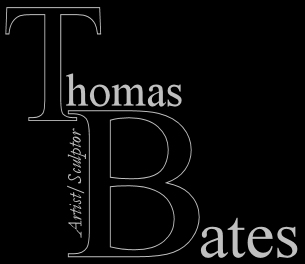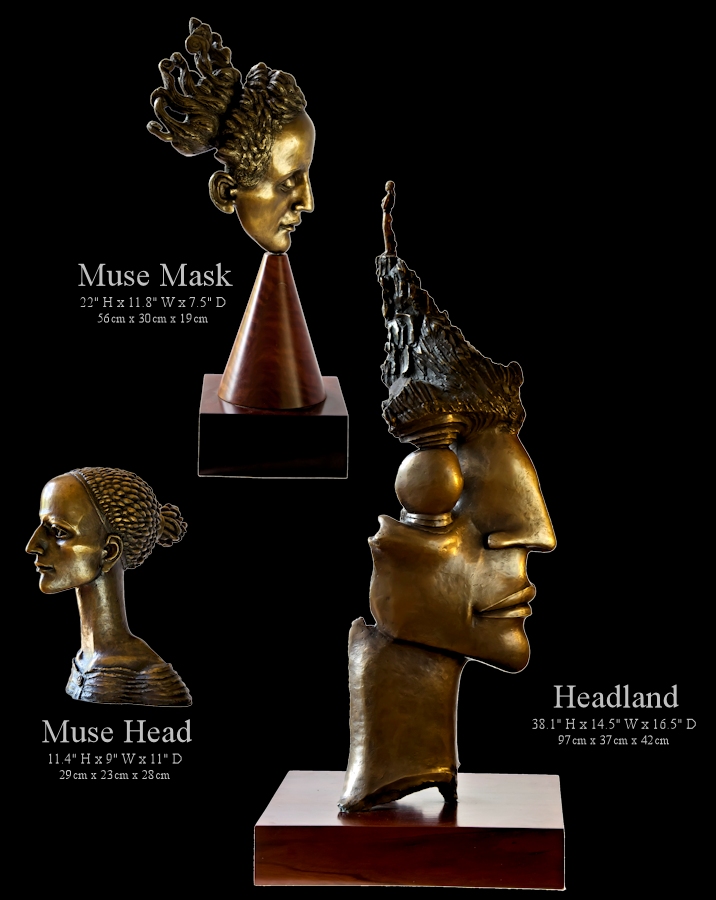At the foundry ~
Casting the actual bronzes involves 2 more moulds being made. The first is a thin silicon piece mould, which is held stable by secondary plaster shells. From this master mould the individual hollow waxes for each cast of the edition are taken by rolling molten wax inside the mould until a thin lining is built up. As the thickness of this lining eventually becomes the bronze, it needs to be about 1/3 of an inch think. As the silicon mould is flexible , once the plaster shell is removed, it can be gently eased off the wax. This process is repeated until the complete edition is made. Each wax is then encased in its own heat resistant waste mould, both inside and out. This mould also has additional drains, funnels and risers, to allow for the wax to be melted out, the molten bronze to be poured in and for the gasses to escape. There are also pins which keep the two shells of inner and outer apart when the wax is melted out in a furnace. The wax drain from the emptied mould is capped off and the mould is filled with molten bronze. This is the actual cast. Once the bronze has cooled, the grog waste mould is removed. The risers and funnels which have also been 'cast' as solid bronze but are definitely not required are skilfully cleaned away, often by bursting them off with a mallet and very sharp chisel and then by filing back to the sculptor's surface. The surface of the bronze requires skilled cleaning and patinating with acids and waxes. This patination creates the surface colour and is carefully achieved through consultation between the craftsman and the artist.
Further notes:
In this way, an edition of 6-10 bronzes is made. At any step, disaster may occur & the cast can fail or be damaged. To achieve casting of the quality of Thomas Bates' bronzes, only the most skillful of founders are used. Larger editions can be made, but in the case of the majority of Bates' work, the editions are kept purposely small to enhance the rarity of these sculptures. Each bronze is considered an original, & after the edition is made, the moulds are destroyed. Each piece is signed, & a certificate to confirm its number in the edition is issued. The number in the edition does not reflect on its value, as each piece is considered an original. This is the time-honoured process of making bronze sculptures & differs from the process of working directly in wax, as many sculptors do, when there is no 'plaster unique' to judge the standard of the bronze cast against. It is time consuming & a highly skillful way of working.
A note on the disappearance of sculptors' casting skills...
It appears that few sculptors these days have the knowledge & skill to work in this way, from clay through piece moulds into plaster uniques for bronzes. These skills disappeared in the 1970s & '80s when they ceased to be taught to sculpture students in most English Art schools. The loss of these casting skills has been regretted by many sculptors, as modelled clay work cannot be preserved indefinitely, whereas plaster uniques are fragile but permanent; there are still Roman plaster existing. Hence a great deal of good clay work is lost by many artists & rather a lot of wax work is cast instead. In tradition, wax was used to make a maquette only, this was then modelled, full size, in clay. By losing this clay modelled part of the process, the subtlety of form which can be achieved in clay, I feel, has been sacrificed to the Gods of time & expense.
Thomas Bates was trained by sculptors who were expert mould makers, who had been young men when English Victorian sculptors trained them. So, Bates comes from a long line of English sculptural tradition which stretches right back, in essence to the Elizabethans & beyond. There are still very skilful founders around who continue to teach complex foundry techniques to apprentices, & though modern methods differ, yet have the same objective: reproduction in bronze.
~ Liz Forsyth, BA Hons.
Among Bates' instructors was sculptor & teacher of outstanding perceptions, Albert Pountney, ARCA, recipient of the Prix de Rome & Rome Scholar. The Prix de Rome is a very prestigious award, & only one person a year gets to go & study in Rome.



